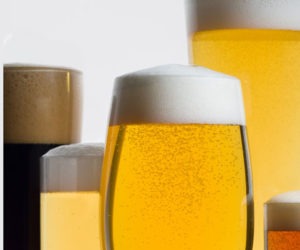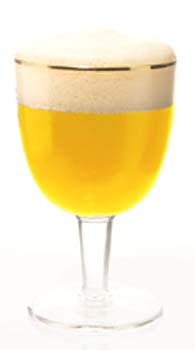Head Games
It’s a thing of beauty. It rises on a pillar of a million tiny bubbles, forming a thick disk of creamy smoothness that makes your mouth water just looking at it.
No, it’s not a scooter pie in a hot tub. Rather, a glass of Guinness stout, with that perfect, creamy white head floating at the top of the jar. The best Guinness is pulled from the tap at your favorite pub or — through the magic of modern technology — poured from a tall “draft can” at home.
There’s magic in that head. Plus a little luck and one key component: nitrogen. It’s the result of years of research and refinement following a simple serendipitous discovery in old Dublin.
Tony Carey, Guinness’ director of technical development in Dublin, has spent the past 32 years studying beer foam and improving it in the Guinness we drink. “Innovation often comes at the interface between production and consumption. Such is the case with the trademark creamy head on a glass of Guinness,” says Carey.
“In the l950s Guinness was still cask-conditioned and shipped to the pubs in a state of late fermentation. The beer was very lively in the barrel and could only be pulled by hand. Even using a beer engine, you ended up with mountains of foam in the glass,” he says.
One enterprising publican came up with his own scheme for getting the foam under control. “He vented the barrel during the cellar condition to prevent excess carbonation. Then, instead of pulling it by hand, he built a compressed-air system to push the beer up to the taproom,” Carey explains.
What the publican quickly discovered was that his Guinness was better than that of the pubs across the street. The head was creamier and longer lasting. His Guinness developed a following, and within 10 years nearly every pub in Dublin was using the air-pressure dispense system and reaping the benefits of the amazing head.
Meanwhile, scientists at Guinness were working tirelessly to unlock the secrets of air’s effect on beer. They eventually solved the mystery and uncovered nitrogen as the key.
Atmospheric air is roughly 78 percent nitrogen. Since we need oxygen (O2) to live, our natural tendency is to think of air as mostly O2, but in fact it is only about 21 percent of the total.
Beer foam is a blend of gas and liquid beer. For reasons we will leave to BYO’s Mr. Wizard to explain, nitrogen bubbles are smaller than carbon dioxide bubbles. When you stack millions of nitrogen beer bubbles atop one another, you end up with foam that contains more liquid beer and less gas than a traditional CO2 based head, hence a denser, creamier head.
Oxidation is the reason Guinness chemists and engineers went about perfecting the nitrogen-based dispense system they use today. It’s a blend of nitrogen and carbon dioxide — no oxygen, so no risk of oxidation. The research also led to the development of the in-can widget system. Carey’s name is among the patentees.
The Foam Thickens
As a homebrewer you might be thinking, “How can I take advantage of this nitrogen phenomenon in my own beer?” Good question.
You can use nitrogen in your home brewery to dress your beers with the classic Dublin head.
If you are imagining pipes, tubes, hoses, and regulators, you are partially correct. If you keg routinely you can use nitrogen in your set-up. It just requires storage and regulation equipment separate from that used for CO2.
Cliff Tanner, proprietor of Braukunst, a homebrew kegging and dispensing supplier in Carlton, Minn., explains: “High-quality nitrogen is available at welding supply houses. You will need a dedicated regulator for the N2, because a CO2 regulator won’t work with nitrogen.”
Blending nitrogen and CO2, the way Guinness does, is not worth the trouble, Tanner says. “Mixed gas is more expensive and difficult to control for carbonation. The preferred method is to ‘carbonate’ the beer with nitrogen — obviously a misnomer here — and dispense as usual with low-pressure CO2.”
You can find nitrogen regulators where you get the gas cylinder.
By far the simplest, cheapest, and possibly most elegant way to get nitrogen in your beer and set a creamy head was inspired, again, by Guinness.
Before the “widget” can, Pub Draught Guinness, was released to the public, Guinness developed an at-home version of the old air-based nitrogen charging system, Guinness Bottle Draft.
Guinness Bottle Draft, in a nutshell, was regular Guinness, only carbonated at a lower-than-normal volume. You had to drink it from a glass to reap the benefits of the system, which featured a small, disposable plastic “initiator” to set a nitrogen-based, creamy head on the beer in the glass.
Each six-pack came with a disposable initiator. The device was a small pump, like a medical syringe without a needle. The beer poured from the bottle with almost no head. The consumer was directed to use the initiator to suck up a little beer, then shoot it back into the glass at high velocity. This brought in some nitrogen-rich room air and seeded a bed of tiny nitrogen bubbles, creating an instant, creamy, Dublin-style head.
Upon discovering the concept, BYO researchers immediately tried to duplicate the technique. In other words, one night either too much beer or too much curiosity encouraged me to zap a glass of homebrew with a child’s medicine syringe.
In many homes with small children, the plastic baby-medicine syringe is a pretty ubiquitous item. A syringe, remember, is not a needle. It’s the thing to which you attach a needle. In the case of the baby-medicine syringe, it is not designed to take a needle but rather to ensure precision when dispensing oral medication. It looks like a large needle syringe, but it has just a small nipple on the end.
Two characteristics make the gadget work as a Dublin-beer-head initiator: The plunger allows liquid to be expelled at high velocity, and the small outflow port allows for efficient aeration of the beer in the glass.
These syringes are sold in most drug stores. Remember, the kind you need has the plunger. Drug stores also sell the rubber-bulb type of medicine dispensers. These are just enlarged eyedroppers and not suitable for beer.
Dosing Your Beer
The technique is exceedingly simple. Pour your homebrew into a glass, leaving an inch or two of headroom. Use the syringe to suck up some beer. Lift the syringe out of the beer and draw the plunger up a little more, until you have drawn an equal amount of air over the beer inside the syringe. You want a 50-50 beer-to-air ratio, but remember this is not rocket science.
Now, keeping the syringe above the surface of the beer, shoot it all back into the glass in one quick motion. Sit back and watch the bubble show. You will see that all-familiar dance, waves of bubbles rising from the bottom of the glass, forming a creamy, dense, nitrogen-seeded head. It’s a sight. One of humanity’s great stress reducers after a hard day at the office.
The lasting power of the air-seeded head you create with the syringe method will depend on your recipe and brewing technique. Many factors contribute to head retention. If your beer is not holding a head on its own, the seeded head will also be short lived.
And what about the dreaded “O” word? You might think that oxidation is a threat when you are deliberately aerating your beer. Don’t worry about it; oxidation rarely lives up to its press clippings. Besides, oxidation is a problem of aging and storage, not of beer that is about to be consumed.
Mind the Fizz
Through trial and error you will learn how much beer to draw into the syringe. It depends on the beer’s starting carbonation level. If you carbonate at a low level, say under two volumes, you will be able to seed a head with two to four milliliters of beer in the syringe. However, if your carbonation is high, 2.5 to three volumes, you will need to use some restraint with the syringe, as one Anheuser-Busch public-relations flak learned the hard way.
Guinness makes Budweiser under contract for Anheuser-Busch in Europe. When the deal was sealed, Guinness and Anheuser-Busch decided to hold a press conference in Ireland, during which the joint venture was to be toasted with glasses of Guinness and Bud. A variety of dignitaries, including ambassadors and Guinness and Anheuser-Busch executives, were on hand for the photo opportunity.
A glass of Bottle Draft Guinness and one of Bud were poured. But before the cameras started clicking, a Guinness media-relations representative stepped in with his plastic initiator. He quickly zapped the stout, setting a perfect creamy head for the photographers.
Of course, in the few moments it took to complete the process, the head on the glass of Bud had fallen away to nothing. That’s when the light bulb blinked in the head of an enterprising Bud public relations man. He stepped forward, grabbed the initiator from his Irish counterpart and zapped the Bud. It erupted like a volcano from the glass, soaking a nearby ambassador with St. Louis’ best!
If your beer is fizzy enough, take it easy with the syringe. And have fun.



